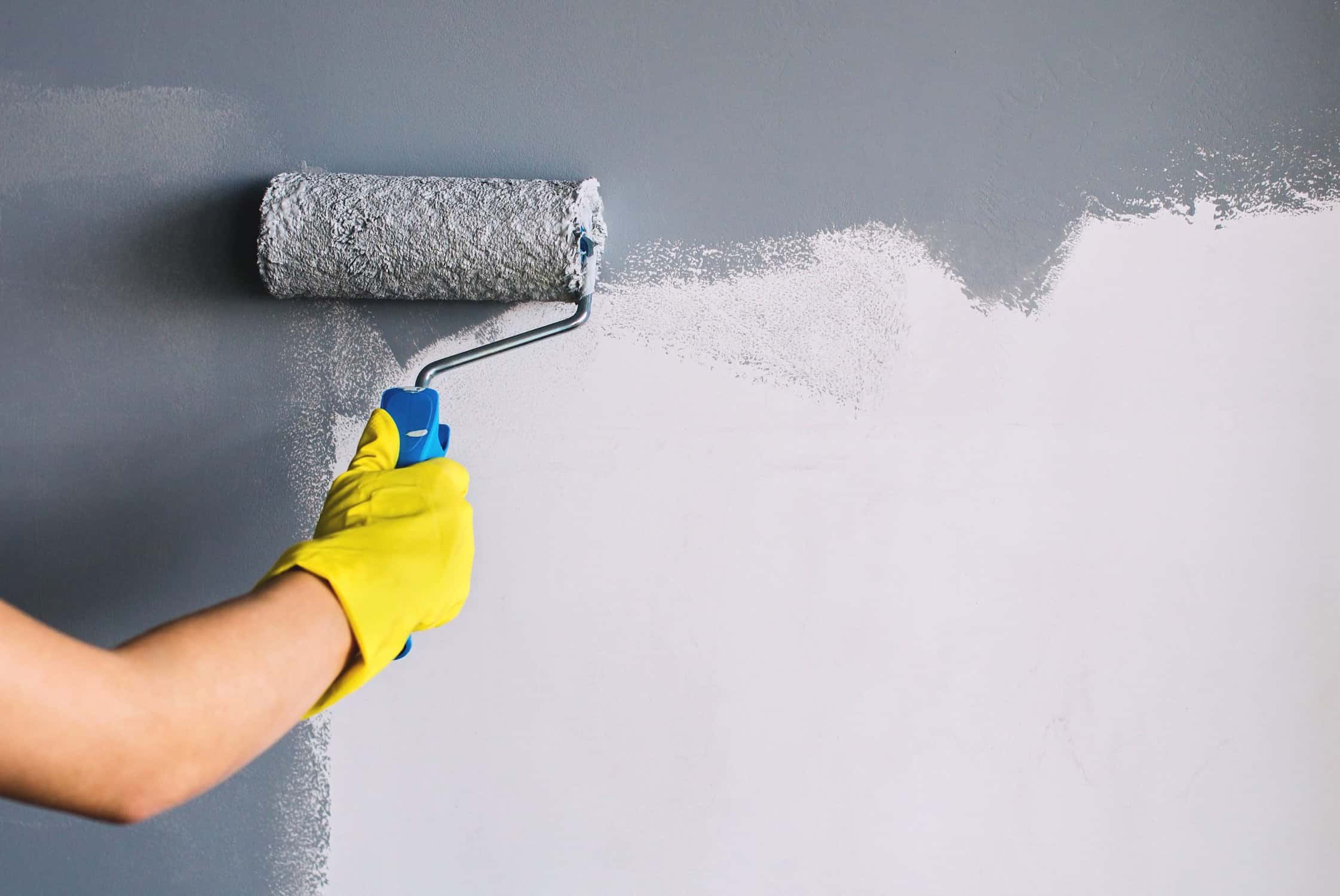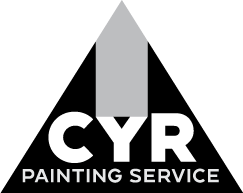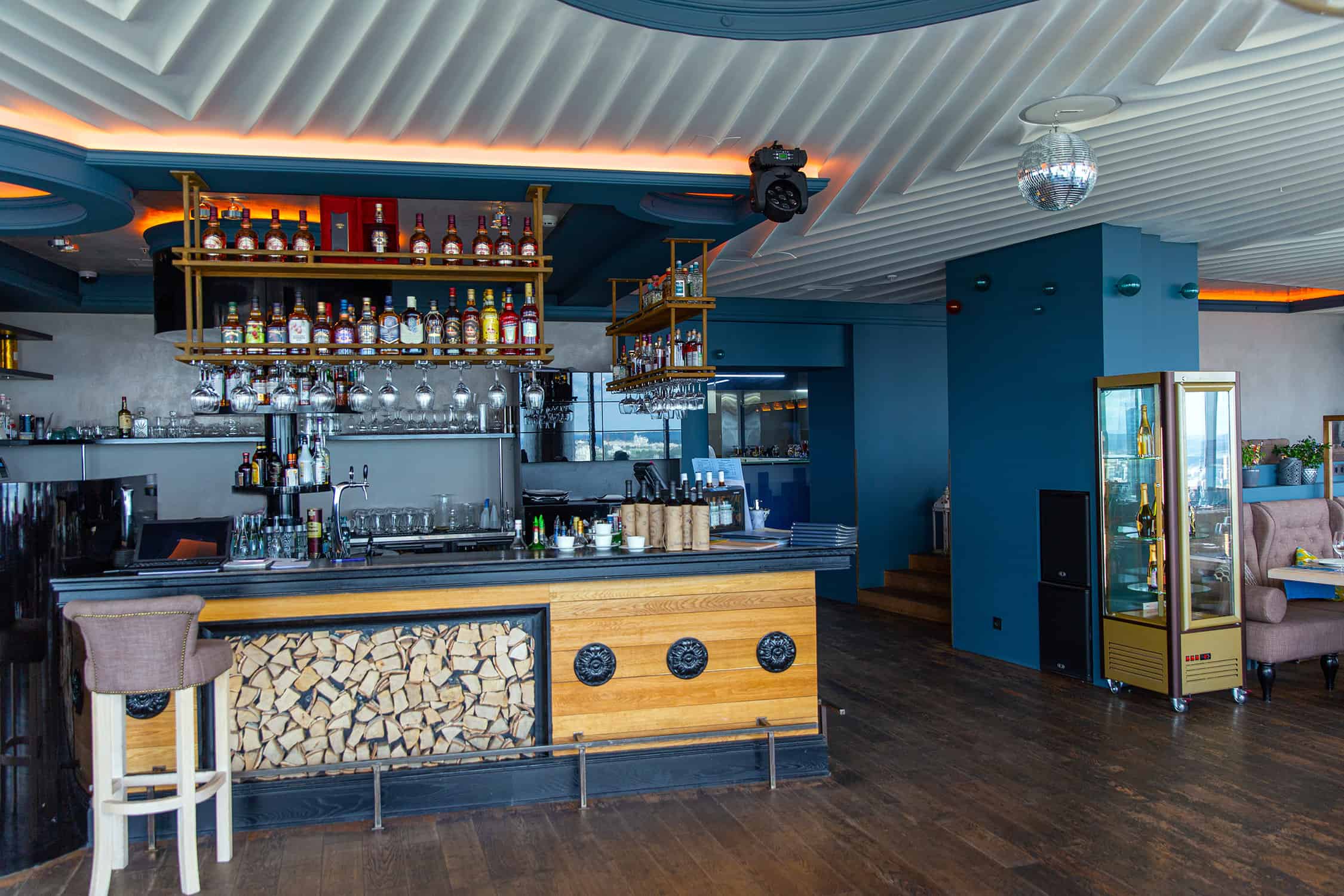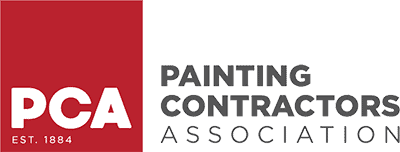Commercial painting projects should be straightforward: get a quote, hire a crew, finish the job, pay the bill. But all too often, things get murky between the estimate and the final invoice.
Hidden fees are one of the most common—and frustrating—issues property owners face when working with painting contractors. Whether it’s equipment rentals, surprise prep charges, or unplanned product upgrades, these unquoted extras can blow your budget, delay timelines, and trigger disputes with contractors or tenants.
This guide breaks down where hidden fees typically come from, how to spot them before you sign a contract, and what every transparent, professional painting quote should include.
What Counts as a Hidden Fee in Painting Contracts?

Hand in yellow glove painting wall in gray color with a roller brush.
Definition and Examples
Hidden fees are charges not clearly disclosed or itemized in the initial painting proposal. They’re often presented as necessary “extras” once the job is underway—or even after it’s complete.
Common examples include:
-
Equipment rentals (e.g., scissor lifts, scaffolding)
-
Extra coats of paint
-
Surface prep not initially included
-
Substrate repairs like patching drywall or filling cracks
-
Change fees for selecting a new paint product
-
Cleanup or hazardous waste disposal charges
These charges might be legitimate work—but if they weren’t disclosed from the start, they qualify as hidden fees.
Why These Fees Happen
There are a few key reasons why painting quotes end up with surprises:
-
Vague proposals that don’t list scope, products, or labor in detail
-
Estimators who don’t visit the jobsite before quoting
-
Intentional lowball pricing to win a bid, knowing change orders will follow
-
Inexperienced estimators who underestimate the complexity of the job
Regardless of the reason, it’s your budget on the line.
Most Common Hidden Fees in Commercial Painting Projects
Surface Preparation Not Included
Prep work is the most commonly omitted—and most essential—line item. A quote might say “includes prep,” but if it doesn’t list what that includes, it’s wide open for interpretation.
Proper prep includes:
-
Pressure washing
-
Scraping or sanding
-
Caulking gaps and seams
-
Repairing drywall or stucco
-
Masking windows, floors, or fixtures
If any of these are missing from the quote, they’ll show up later—as extra charges.
Primer and Additional Coats
Some cheap quotes cover just one coat of paint. Others skip the primer altogether.
That might be fine over a white wall—but not over darker surfaces or porous materials.
Example:
Sherwin-Williams SuperPaint often requires two coats over medium to dark colors.
Elastomeric coatings, such as Loxon XP, require a base primer and build to a specific mil thickness.
Failing to plan for these coatings upfront can lead to “unexpected” second-coat charges.
Equipment Charges
For projects with high ceilings, stairwells, or exterior walls, lifts, scaffolding, or fall-protection systems may be required.
If the quote doesn’t mention this, expect a rental invoice mid-job.
Material Upcharges
Many painting crews quote with mid-grade products to get the job—but then suggest “upgrading” once work begins.
For example, switching from a standard acrylic to Sherwin-Williams Harmony (a zero-VOC, low-odor paint suitable for occupied interiors) can increase material costs by 15–25%.
Quotes should be product-specific from the start—by name, line, and sheen.
Off-Hours or Weekend Labor
Some facilities require painting work during off-hours to avoid disrupting operations. This is common in:
-
Hospitals
-
Retail stores
-
Educational facilities
-
Hotels
But if weekend labor or after-hours work isn’t covered in the original quote, you’ll likely see an overtime surcharge later.
Color or Product Changes Mid-Job
Switching paint colors midstream—or even altering sheen—can result in:
-
Paint return fees
-
Re-tinting charges
-
Additional labor for re-coating
Professional painters should offer test patches or mock-ups before finalizing choices to avoid costly adjustments later.
Cleanup and Waste Disposal
Surprisingly, not every contractor includes cleanup.
That means leftover paint cans, plastic masking sheets, or sanding dust might remain behind—or worse, you’re billed for removing them afterward.
What a Transparent Painting Quote Should Include
Line-Item Breakdown
Every transparent quote should provide a line-item cost structure that includes:
-
Labor by hours or crew size
-
Material costs with product brands and lines
-
Equipment rentals (if applicable)
-
Prep details
-
Cleanup and waste disposal
-
Terms for changes or additions
This makes comparison easy and eliminates ambiguity.
Scope of Work
The scope should describe exactly what’s being painted and how:
-
Total square footage
-
Surface types (wood, drywall, stucco, metal)
-
Areas (walls, ceilings, doors, baseboards, railings, etc.)
-
Application method (brush, roller, spray)
A vague description like “interior office repaint” is not enough.
Number of Coats + Primer
A professional quote should clearly specify:
-
Number of coats (2 is standard)
-
Type and brand of primer
-
Paint brand, product line, sheen, and VOC rating
-
Expected coverage per coat
Examples:
-
Sherwin-Williams Pro Industrial DTM for metal handrails
-
Benjamin Moore Scuff-X for high-traffic healthcare hallways
Warranty and Callbacks
Warranties should cover both product and labor:
-
1–5 years for workmanship
-
Manufacturer warranty for coating performance
-
Clarification on whether touch-ups or callbacks are included
If there’s no warranty language, ask why.
Questions to Ask Your Painter to Prevent Surprise Charges
“Is surface preparation included? What exactly does that cover?”
Don’t settle for vague answers. Make sure it includes caulking, sanding, priming, and patching if needed.
“What happens if we need a third coat?”
Coverage issues happen. Ask whether extra coats are included if colors don’t cover as expected.
“Is equipment rental part of your quote?”
If you’re painting exteriors, high ceilings, or stairwells—ask whether scissor lifts, booms, or scaffolding are priced in.
“Are there fees for working after hours?”
Especially in tenant-occupied or 24/7 environments, confirm off-hour labor is priced.
“Do you charge extra for premium or specialty paints?”
Antimicrobial, elastomeric, or epoxy coatings often cost more. Know your products upfront.
Product-Specific Scenarios Where Fees Can Hide
Elastomeric Coatings
These coatings are popular for stucco or tilt-up concrete buildings. But they:
-
Require specialty primers (e.g., Sherwin-Williams Loxon)
-
Must be applied at a specific mil thickness
-
Consume more material per square foot
If these aren’t planned from the beginning, you’re paying for them later.
High-Performance Interior Coatings
Hospitals, food-prep areas, and schools often use:
-
Benjamin Moore Scuff-X: resists abrasion and frequent cleaning
-
PPG Break-Through: dries quickly, bonds to challenging surfaces
These coatings cost more—but are required for compliance or performance. Your painter should flag this in advance.
Moisture or Rust-Prone Areas
Painting over rust without the proper Direct-to-Metal (DTM) or epoxy basecoat is a recipe for failure. It might not show right away—but it’ll lead to full recoating within months.
Sample Transparent Quote vs. Hidden Fee Risk Quote
| Line Item | Transparent Quote | Risky/Lowball Quote |
|---|---|---|
| Surface Prep | Includes pressure washing, patching, and priming | “Basic prep included” |
| Coats | 2 coats + primer | “1 coat paint” |
| Paint Type | Sherwin-Williams SuperPaint, Satin | “Mid-grade paint” |
| Equipment | Lift rental included | Not mentioned |
| VOC Rating | Low-VOC, LEED-compliant | Not specified |
| Off-Hours | Included | “May be extra” |
| Warranty | 3-year workmanship, 7-year product | None listed |
| Cleanup | Post-job cleanup and disposal included | Silent |
This kind of comparison is why line-item clarity matters.
Legal and Contract Clauses to Watch For
Change Order Policies
The contract should clearly state:
-
How changes are proposed
-
When they’re priced
-
Who must approve them
No clause? You could be handed surprise charges without recourse.
“T&M” (Time and Materials) Language
T&M billing is open-ended unless capped. Ask for:
-
A hard ceiling on costs
-
Approval before overruns
-
Hourly rate breakdowns for labor and materials
Payment Schedule
The safest model is milestone-based:
-
Deposit
-
Payment after prep completion
-
Final payment after walkthrough and approval
Avoid contracts demanding 50% upfront without performance milestones.
Smart Business Owner Tips for Fee-Free Painting Projects
Get 2–3 Detailed Bids
Don’t just compare bottom lines. Review what’s included and excluded in each.
Schedule a Walkthrough
Onsite inspections reduce guesswork—and help identify prep or substrate repair needs upfront.
Ask for Product Specs and Data Sheets
Make sure every coating used is product-named and backed with a Technical Data Sheet (TDS).
Clarify Prep and Cleanup
Don’t assume anything. Ask whether these are priced in—and get it in writing.
Choose Value, Not Just Price
A $10,000 transparent quote that lasts 8 years is cheaper than a $7,000 lowball job that fails in 2 years with $3,000 in add-ons.
Conclusion
Hiring a painting contractor shouldn’t feel like playing defense. If the estimate is vague, padded with allowances, or filled with jargon, there’s a high chance hidden fees are coming your way.
Smart business owners insist on clarity—on scope, materials, labor, and costs. The most accurate quote isn’t always the cheapest up front—but it is the most reliable, honest, and cost-effective over the long term.
Tired of unclear quotes and last-minute add-ons?
Get a transparent, line-item commercial painting proposal tailored to your building. No surprises—just solid prep, high-performance coatings, and clear expectations.



